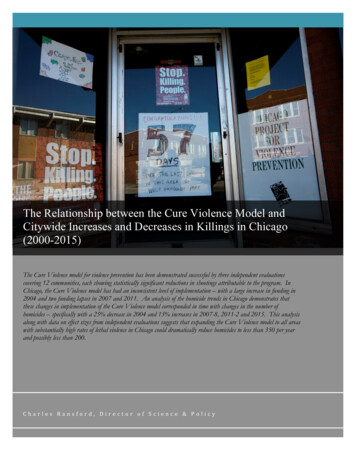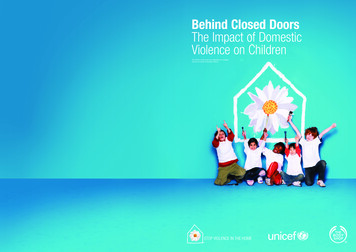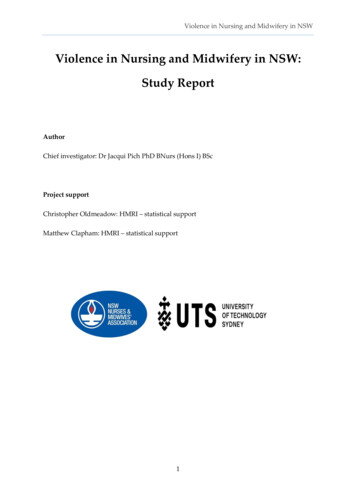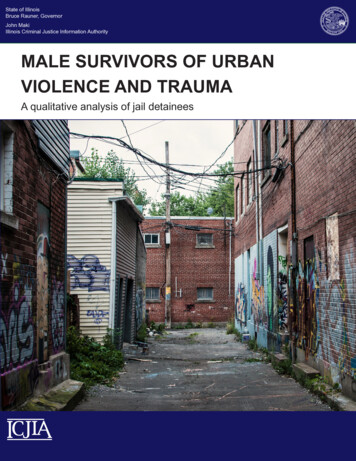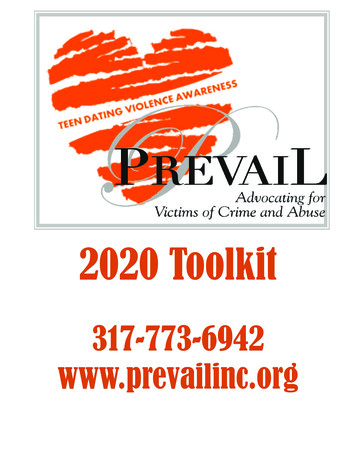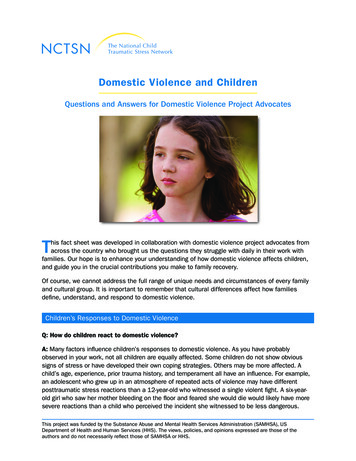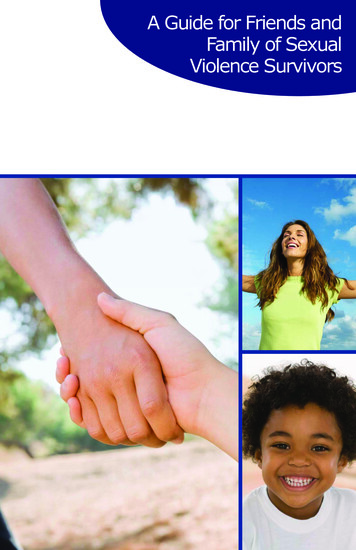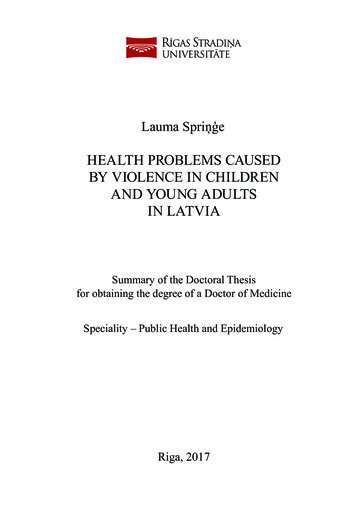
Transcription
Lauma SpriņģeHEALTH PROBLEMS CAUSEDBY VIOLENCE IN CHILDRENAND YOUNG ADULTSIN LATVIASummary of the Doctoral Thesisfor obtaining the degree of a Doctor of MedicineSpeciality – Public Health and EpidemiologyRiga, 2017
The Doctoral Thesis was carried out at Rīga Stradiņš University.Scientific supervisor:Dr. med., Associate Professor Anita Villeruša,Rīga Stradiņš University, LatviaOfficial reviewers:Dr. med., Professor Ģirts Briģis,Rīga Stradiņš University, LatviaDr. psych., Professor Sandra Sebre,University of LatviaDr. med., Professor Birute Strukcinskiene,Klaipeda University, LithuaniaDefence of the Doctoral Thesis will take place at the public session of theDoctoral Council of Medicine on 26 September 2017 at 15.00 in HippocratesLecture Theatre, 16 Dzirciema Street, Rīga Stradiņš University.The Doctoral Thesis is available in the RSU library of and at RSU webpage:www.rsu.lv.Secretary of the Doctoral Council:Dr. med., Mg. sc. sal., Assistant Professor Inese Gobiņa
ANNOTATIONIntroduction. The goal No. 16.1 of the UN Sustainable DevelopmentGoals aims to significantly reduce all forms of violence. Children are the part ofsociety that must be particularly protected from violence and its adverse effects.To identify and successfully solve the problem of violence, it is necessary toidentify the extent of the problem, as well as to understand its impact onchildren's health and well-being in the long term. Violence is a multifactorialphenomenon, therefore, the influence of beliefs and values of family, localcommunity, culture and social values must be considered when researching,interpreting the results and addressing the problem of violence.The aim of the thesis was to assess the prevalence of violence and itsforms in the population of children and young adults of Latvia, and itsrelationship between the risk factors associated with family, health and itsassociated disorders, as well as to find out the expert opinions on how the childvictims perceive the violence, the consequences of violence, and copingmechanisms and rehabilitation.Material and Methods. In the quantitative part of the research data fromrepresentative cross-sectional study on the adverse childhood experiences ofyoung adults in Latvia were used. Based on the WHO recommendations, thestudy tool used was a questionnaire from the Adverse Childhood Experiences(ACE) Study. Overall, 1223 cases were analysed. The frequency distribution,cross tabulation and Chi-Square Test (χ2) were used for statistical dataprocessing. The relationships were calculated by odds ratio, stratified odds rationbased on Mantel-Haenszel's method, Spearman's rank correlation coefficient andmultiple logistic regression.In the qualitative part of the study to find out the experiences of expertsdealing with child victims of violence, in-depth semi-structured expertinterviews were conducted with psychologists and doctors-psychotherapists,3
working with child victims of violence. Overall, 14 experts were interviewed.The method used for the interview data processing was thematic analysis.Results. Most often young adults in childhood have experiencedemotional violence (31.5%), physical (27.0%) and emotional (23.8%) neglect,but less frequently suffered from physical (16.4%) and sexual (10.3%) violence.Women have experienced violence more often than men. Children whosefamilies had the following risk factors: low socio-economic status, parents'divorce, father's violence against mother, psycho-emotional health problems andalcohol abuse, had higher odds for experiencing one or more forms of violence,as compared to the children from families without the above mentioned riskfactors. Multivariate regression analysis suggested that the young adults whohad experienced some form of violence (except sexual abuse) in childhood, hada 1.2–2.2 times (depending on the form of violence) higher odds for poor healthself-assessment, compared to young adults who did not witness violence inchildhood. Physical and emotional violence experienced during childhoodincreased the odds ratio of excessive alcohol use in adolescence by 1.4 and1.2 times. Young adults who experienced physical and emotional violence, andemotional neglect during childhood, had a respectively 2.6, 2.3 and 2.1 timeshigher odds of developing mental health problems during adolescence, comparedto young adults without such experience. Violence (except sexual violence)experienced during childhood increased the odds of suicide attempts atadolescence by 2.0–4.0 times, compared to young adults without violentexperience.Following the interpretation of the interviews, the question section on thevictims' experience of violence and the understanding of the concept of violence,highlighted three topics: the conceptual diversity of the notion of violence,characteristics of the experience of child violence, and child's openness on theexperienced violence. The section on the impact of violence on child's health,outlined two topics: effects on the physical and psycho-emotional health, and the4
factors that influence health effects. The section dealing with the way in whichthe child victims of violence overcome the caused disorders, and what is the roleof institutions in this process, outlined three topics: characterization of strategiesfor overcoming disorders, dealing with the child victim of violence, systemicrequirements of rehabilitation.Conclusions. Violence against children is a pressing issue of publichealth. Children from dysfunctional families have higher odds to experienceviolence. Violence experienced in childhood is associated with increased oddsfor having a bad health self-assessment, excessive alcohol consumption,development of psycho-emotional health problems, and suicide attempts inyoung adult age. The key topics in the analysis of the expert interviews were:conceptualization of the notion of violence, characteristics of the experience ofviolence, effects of violence and coping mechanisms, as well as the child victim'sneeds in rehabilitation process.5
TABLE OF CONTENTSANNOTATION . 3ABBREVIATIONS . 81. INTRODUCTION . 91.1 Novelty of the problem. 91.2 Aim of the thesis. 121.3 Objectives of the thesis . 121.4 Hypotheses of the thesis . 131.5 Research question of the thesis . 132. MATERIAL AND METHODS . 142.1 Quantitative research . 142.1.1 Data sources and extraction . 142.1.2 Variable characteristics and grouping of the subjects . 142.1.3 Characteristics of the study population . 172.1.4 Statistical analysis . 172.2 Qualitative research . 192.2.1 Data extraction . 192.2.2 Selection and profile of respondents . 202.2.3 Data processing method . 213. QUANTITATIVE RESEARCH RESULTS . 223.1 The prevalence of violence and the interrelation of types of violence . 223.2 Violence experienced in childhood in relation to risk factorsassociated with family . 233.3 The factors associated with the health and family of young adults . 253.4 Violence experienced in childhood and factors associatedwith the health of young adults . 284. QUALITATIVE RESEARCH RESULTS . 336
4.1 Experience of child victims of violence and understandingof the concept of violence . 334.1.1 Diversity of the conceptualization of violence . 334.1.2 Characteristics of the children's experience of violence. 334.1.3 The openness of the child victim about the violence . 344.2 The impact of violence on health . 344.2.1 The impact on the physical and psycho-emotional health. 344.2.2 The factors that influence health effects. 354.3 Strategies for overcoming disorders caused by violence,the role of institutions . 354.3.1 The characterization of coping strategiesfor overcoming disorders . 354.3.2 Dealing with child victim . 364.3.3 The systemic requirements of rehabilitation . 375. DISCUSSION. 396. CONCLUSIONS. 487. PRACTICAL RECOMMENDATIONS . 51REFERENCES . 54PUBLICATIONS AND THESES . 57GRATITUDES . 617
ABBREVIATIONSCMCabinet of MinistersSESsocio-economic statusUNUnited NationsWHAWorld Health AssemblyWHOWorld Health Organization8
1. INTRODUCTION1.1 Novelty of the problemViolence is a pressing issue in society, which not only restricts theindividual's rights to a safe and violence-free living space, but also creates alasting adverse impact on the health of the individual and the common publichealth. The goal No. 16.1 of the UN Sustainable Development Goals aims tosignificantly reduce all forms of violence (United Nations, 2017). Based on thatobjective, at the 69th World Health Assembly on May 27, 2016, the WHAendorsed a resolution (WHA 69.5) to reduce violence, with particular emphasison women and children as the most vulnerable groups of society (World HealthOrganization [WHO], 2014a) .Children are one of the groups of society who need special protectionagainst violence. According to the statistics, approximately 850 children agedunder 15 (WHO, 2013a) die in a violent death every year in the European region,but the number of children who from day to day are victims of one or more formsof violence, like physical or emotional violence, sexual abuse or neglect, is evenhigher. Although the family is a place where the child can receive the necessarycare and support to develop and successfully prepare for an independent life, thefamily can also be a place where child's health and well-being are threatened,since violence against children most commonly occurs in the family (Gilbertet al., 2009).Discovering the prevalence of violence against children is one of the tasksassigned by the WHO. The prevalence of violence experienced in childhood wascalculated based on several studies and reported in a WHO European report onreducing violence against children. Most often children had suffered fromemotional (29.1%) and physical (22.9%) violence, but 18.4% had been victimsof emotional neglect and 16.3% had suffered from physical neglect. Sexual9
violence against the child is the least frequent violence, 13.4% of girls and 5.7%of boys were reported to be victims (WHO, 2013a). The report highlights thenecessity for new studies to better identify the burden of violence on children,particularly paying attention to emotional violence and neglect.The interpretation of the prevalence indicators of violence againstchildren is based on a number of specific aspects which may affect the value ofindicators. First of all, the data source used is of key importance. The cases ofviolence against children registered in institutions cover only a part of all casesof violence against children. Epidemiological studies are used to identify andresearch the issue more comprehensively, surveying respondents about theirexperience of violence. The number of instances of violence against childrenidentified in the institutions is estimated to vary up to ten times when comparedto the number of cases identified in the population-based studies (Gilbert, 2009).The second major issue is associated with the perception and understanding ofthe concept of violence in society. Violence against children as a specific issueof the public appeared only in the last century; however, certain forms ofviolence, such as emotional violence against a child as a separate form ofviolence, has only been studied and described over the past 25 years (Cindy andMiller-Perrin, 2013). Therefore, the concept of violence against children and itsdifferent forms is not ambiguous in the society, and the concept of violence alsois impacted by local communities, cultural and community values, views andattitudes (Pinheiro, 2006). Taking into account the topicality of the issue and thehigh prevalence rates, as well as the variety of the interpretations of violence, itis important to discover the prevalence of violence against children in thepopulation of Latvia as well.Violence during childhood causes not only immediate negativeconsequences, but may also have long-term adverse effects on the health andwell-being of the affected person in a later life. Evidence from epidemiology andneurobiology studies has shown that the stress experienced during childhood10
results in changes in the brain structure and physiology of the affected person,which may influence human behaviour in the long term, as well as cause longterm adverse health effects (Anda et al., 2006). Studies observe different healthand health-related behaviour indicators, depending on whether the respondenthas experienced any violence during childhood.Young adults are the human capital of the future, and one of the prioritiesin public policy documents. In the Latvian Youth Policy Plan 2016-2020 (2016No. 256), the health of young adults is identified as one of the essentialpreconditions for the successful migration of the individual from child to adultage, and full integration of young adults into society. It was demonstrated in asurvey that the rate of health self-assessment of 16 to 24 year old young adultswas higher than the rate of health self-assessment of the total population ofLatvia; however, among the EU member states, the Latvian young adults havethe lowest proportion of good or very good health self-assessment (LR Centrālāstatistikas pārvalde [CSP], 2014). Health is one of the components of the qualityof life and an essential precondition for productivity and social welfare, which iswhy it is essential to clarify and identify the potentially influential elements ofthe health of young adults.The parameters associated with the mental health reflect the ability ofyoung adults to cope with the challenges and problems of their age. Data frompopulation health behaviour studies show that 39.3% of young people aged15–24 have experienced tension, stress and depression in the last month (Slimībuprofilakses un kontroles centrs [SPKC], 2015). There is also a high level ofsuicides in the youth population of Latvia, which is the second most frequentcause of death in this age group (WHO, 2017).An association between childhood experience of violence and excessivealcohol consumption during a later period of life has been observed in studies onchildhood experiences of violence. Excessive consumption of alcohol in theyouth population of Latvia is one of the public health problems. According to the11
results of the international study ESPAD, 63% of boys and 67% of girls aged 15have used alcohol in the last month. In Latvia, this figure is higher than the totalpopulation of the study, which includes 35 countries of the European region(SPKC, 2016).Based on the health and health-related behaviour developments of youngadults in the population of Latvian youth, as well as studies conducted in otherparts of the world on the adverse effects of violence experienced duringchildhood on the individual's later life, the focus of the doctoral thesis was toanalyse the impact of the violence experienced during childhood on the healthself-assessment, excessive alcohol consumption, psycho-emotional healthproblems and suicide attempts of young adults in Latvia.1.2 Aim of the thesisThe aim of the thesis was to assess the prevalence of violence and itsforms in the population of children and young adults of Latvia, and itsrelationship between the risk factors associated with family, health and itsassociated disorders, as well as to find out the expert opinions on how the childvictims perceive the violence, the consequences of violence, and copingmechanisms and rehabilitation.1.3 Objectives of the thesis1. To find out the gender-specific prevalence of childhood experiencedphysical, emotional, sexual violence, and neglect in the population of youngadults;2. To analyse the associations between violence experienced in childhood withthe social, economic and psycho-emotional factors of the family;12
3. To identify the association between violence experienced in childhood withparameters associated with the health of young adults;4. To evaluate the effect of violence experienced in childhood on the parametersassociated with health, when adjusted to parameters associated withdemographics and family of the young adults;5. To find out the experience and views of psychologists and psychotherapistsworking with children who are victims of violence, and their views on howthe child victims perceive the violence, the consequences of violence, andcoping mechanisms and rehabilitation.1.4 Hypotheses of the thesis1. There is a relationship between risk factors associated with family andviolence and neglect forms experienced in childhood in gender groups ofyoung adults;2. There are differences in the parameters associated with health betweengroups of young adults with different experiences of childhood violence.1.5 Research question of the thesisWhat are the experts’ opinions on the child victim’s experience ofviolence, and its impact on health and rehabilitation?13
2. MATERIAL AND METHODS2.1 Quantitative research2.1.1 Data sources and extractionThe data in the thesis was derived from the Disease Prevention andControl Centre 2011 study on the adverse childhood experiences of young adultsof Latvia. The design of the study is a retrospective cross-sectional study. Thetarget population of the study is the young adults of Latvia. The study tool is aninternationally recognised and developed questionnaire on the adverse childhoodexperiences.2.1.2 Variable characteristics and grouping of the subjectsDependent characteristicsHealth self-assessment. Responses were dichotomized into two groups –good (combining responses of ‘good’ and ‘fairly good’) and bad (combiningresponses of ‘fair’, ‘bad’, ‘very bad’) health self-assessment.Excessive alcohol consumption was defined as having been intoxicatedat least once in the past 30 days.Psycho-emotional health problems were identified if the respondent hadexperienced at least two of the four complaints (depression, irritability,nervousness, and difficulty falling asleep) at least once a week in the past sixmonths. To establish suicide attempts, the respondents had to respond toquestion: ‘Have you ever attempted to commit suicide?’14
Independent variablesThe experience of physical violence was identified by questions: ‘Whileyou were growing up, how often a parent or other adult in the household:(1) grab, push, slap, or throw something at you; (2) ever hit you so hard that youhad marks or were injured’. Physical violence was identified if the answers to thefirst question were ‘often’, ‘very often’, and/or the answers to the secondquestion were ‘one, two times’, ‘sometimes’, ‘often’, ‘very often’.The experience of emotional violence was identified by two questions:‘While you were growing up, how often a parent or other adult in the household:(1) swear at you, insult you or humiliate you, (2) and act in a way that made youafraid that you might be physically hurt’. Emotional violence was identified ifthe answers to the first question were ‘often’ or ‘very often’, and/or the answersto the second question were ‘one, two times’, ‘sometimes’, ‘often’, ‘very often’.To assess sexual violence, the respondents were asked two questions:‘During your first 18 years of life, did an adult, older relative, family friend orstranger ever perform the following activities?: (1) touch or fondle your body ina sexual manner, (2) try to have any kind of intercourse (oral, anal, or vaginal)with you’. Sexual violence was established if the answer to one or both questionswas ‘yes’.Physical neglect against children was identified, using five statements:‘How often each one of these statements is true when considering the first 18years of your life: 1) you didn't have enough to eat; 2) Your parents were toodrunk or high to take care of the family; 3) you had to wear dirty clothes; 4) youknew that there is someone who takes care and protects you; 5) there wassomeone to take you to the doctor if you needed it.’ Physical neglect wasestablished if the respondent replied ‘often’, ‘very often’ to one of the first threequestions, but responded with ‘never’, ‘rarely’ to the last two questions.Emotional neglect was identified by the following questions: ‘How ofteneach one of these statements is true when considering the first 18 years of your15
life: 1) There was someone in your family who made you feel important orspecial; 2) you felt loved in your family; 3) people in your family looked out foreach other; 4) you felt like someone in your family hates you; 5) you felt likeyour parents wished you were never born.’ Emotional neglect was defined if therespondent replied ‘never’, ‘rarely’ to one of the first three questions, butresponded with ‘sometimes’, ‘often’, ‘very often’ to question four and five.A number of independent variables reflecting the respondent's familyenvironment were included in the thesis. To define the socio-economic situationof the family, the Family Affluence Scale was used.To find out about parental divorce or separation, the respondents wereasked whether their parents had ever lived separately or been divorced.Father's violence against mother was determined by asking fourquestions with answers ‘never’, ‘one, two times’, ‘sometimes’, ‘often’,‘very often’: ‘While you were growing up, how often your father/stepfather ormother’s partner: (1) pushed, grabbed, or had something thrown at your mother?;(2) kicked, pulled hair or hit your mother with a fist or something hard;(3) repeatedly hit your mother over at least a few minutes; (4) threatened yourmother with a gun or knife with the intention to hurt her?’ Violence against awoman in the family was defined if the respondent answered ‘often’, ‘very often’to the first question, ‘sometimes’, ‘often’, ‘very often’ to the second question, orif they responded with ‘one, two times’, ‘sometimes’, ‘often’, ‘very often’ to thethird and fourth question.Excessive alcohol consumption in the family was defined if therespondent gave an affirmative response to whether there was a problem drinkeror alcoholic in the family.Mental health problems in the family were defined if the respondentreplied affirmatively to one of these questions: 1) Was a household memberdepressed or mentally ill; 2) Did a household member ever attempted to commita suicide.16
2.1.3 Characteristics of the study populationIn total, 1223 respondents (615 males and 608 females) aged18 to 25 years were included in the data analysis. The average age of respondentswas 18.6 years (standard deviation 0.98). Of all respondents, 89.9% were aged18-20 years. Among all respondents, 59.3% (n 725) were high school students,and 40.7% (n 498) were students of a vocational education institution. Only10 respondents in general secondary schools were older than 19 years, but theage distribution in vocational education institutions was as follows: 18 years(37.1%), 19 years (35.5%), 20 years (14.9%), 21 years (5.8%), 22 years (3.1%),23 years (1.9%), 24 years (1.0%) and 25 years (0.8%).2.1.4 Statistical analysisMethods used for data analysis were descriptive statistics: frequencydistribution, calculation of the mean value, cross tabulation. Chi-square test in2 2 tables was used for comparison of respondent subgroups. For comparisonof independent groups whose number exceeds two groups, the method used wasdetermination of binomial proportion confidence interval, by using Wilson ScoreInterval (Erdoğan and Gülhan, 2016). Spearman's rank correlation coefficientwas used to measure the correlation between types of violence.To determine the relationship between the dependent and independentcharacteristic of the study, the calculation of odds ratio was used. For associationbetween the childhood experience of violence and risk factors associated withfamily, a gender stratification analysis in 2 2 k tables was performed todetermine the two-factor relationship differences in gender groups. Calculationswere performed by using the Mantel-Haenszel method, where the null hypothesisstates that there is no relationship between gender strata. The null hypothesis was17
rejected if the Mantel-Haenszel test p value was less than 0.05 (McDonald,2014).The impact of various types of violence on the parameters associated withthe health of young adults - health self-assessment, complaints about psychoemotional health, excessive alcohol consumption and suicide attempts, wasanalysed in the multiple logistic regression.Association between violenceexperienced in childhood and factors associated with health, was adjusted to therespondent's gender and factors associated with family. Separate multivariateregression analysis was performed for each type of violence.The independent variables included in the regression model were testedfor collinearity, to determine whether the independent features do not mutuallycorrelate too closely. The purposeful selection method was used for the selectionof variables that would be included in the multivariate regression models.Initially, the relationship between each variable and the result was defined byusing univariate regression analysis. Variables with a p value 0.025 wereincluded in the regression models. This value, instead of the conventional 0.05,of the p value was defined to include all variables which are significantindependent variables of the regression model. The effect of confounding factorwas tested in regression models. The variable was assumed to be the confoundingfactor when the odds ratio was observed to change for at least 15% when adjustedto other variables included in the regression model (Bursac, Gauss, Williams andHosmer, 2008). Multiplicative interaction of independent variables with otherindependent variables was tested in regression models.Value of (p) 0.05 was defined for all statistical tests. The results wereconsidered statistically significant at p 0.05. Software MS Excel and IBM SPSSwere used for data analysis.18
2.2 Qualitative research2.2.1 Data extractionIn the qualitative part of the study for obtaining information on theexperience of experts dealing with child victims of violence, in-depth and semistructured interviews with experts (psychotherapists, psychologists andpsychotherapists-doctors) were used as a tool of data extraction. Qualitativeresearch draws attention to the processes, the nature and structural characteristicsof the phenomenon, and helps the researcher to look into the researchphenomenon (Flick, Kardoff and Steinke, 2004). In empirical social research,expert interviews are a suitable and often used tool to help the researcherunderstand the main problems in the research field and provide the field'scontextual characteristics. The expert interviews in the thesis are an additionalsource of information providing a contextual knowledge of the target population(child victims of violence) (Bogner and Menz, 2009).The protocol of the questions of the expert interviews consisted of threesections of questions. In the first section, the experts were asked about theexperience of child victims of violence, and how the children understand thephenomenon of violence. The second section of questions clarified the experts'experience on the consequences of violence on the victim's health. The thirdsection established the opinions of the experts on the overcoming strategies ofviolence of the child victims, and the role of institutions in this process.A permission of the Ethics Committee of Rīga Stradiņš University toconduct expert interviews was received. The principles of qualitative researchethics were observed - obtaining informed consent, providing confidentiality andresponsibility for the consequences of the research (Rohleder
emotional neglect during childhood, had a respectively 2.6, 2.3 and 2.1 times higher odds of developing mental health problems during adolescence, compared to young adults without such experience. Violence (except sexual violence) experienced during childhood increased the odds of suicide attempts at adolescence by 2.0 -

